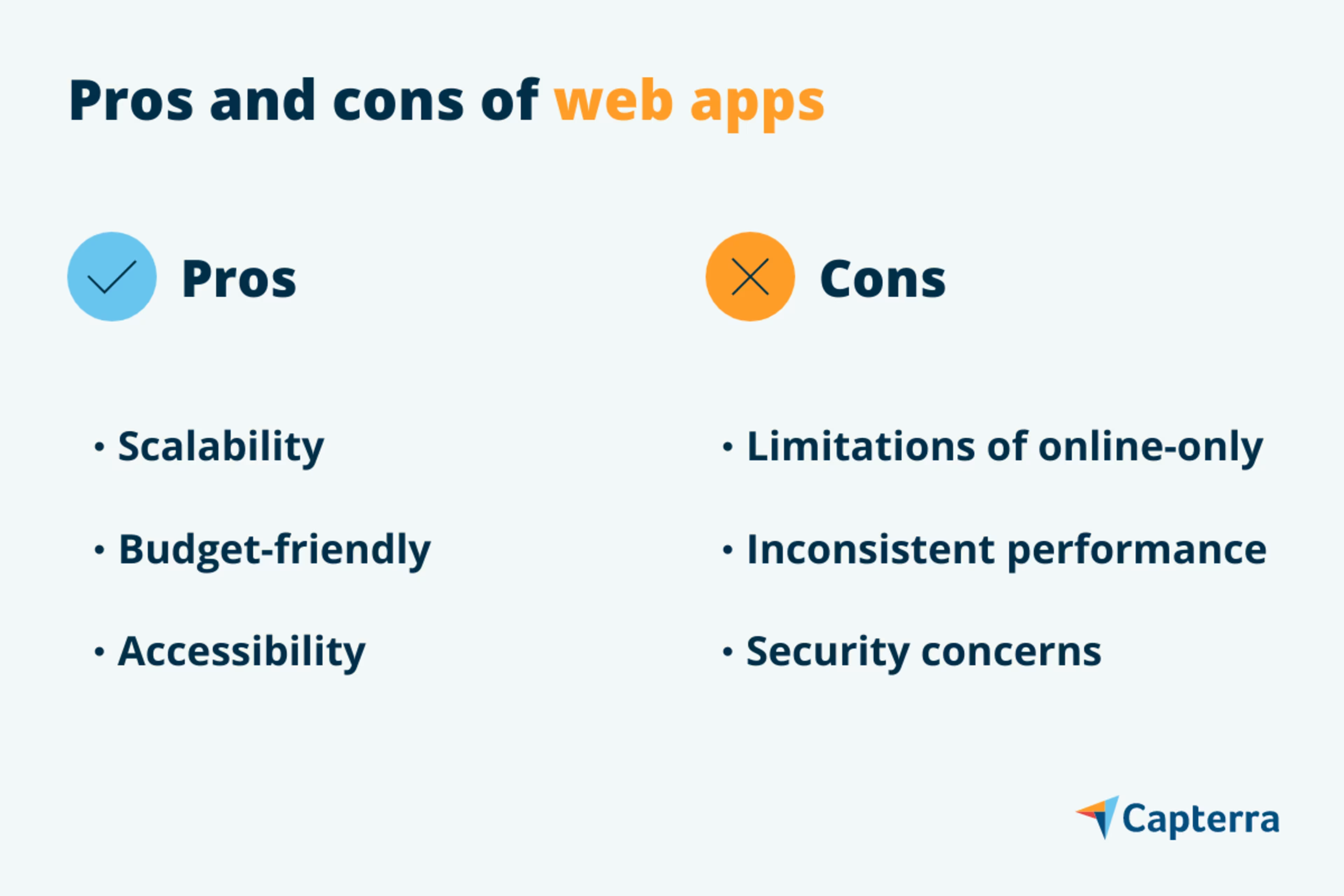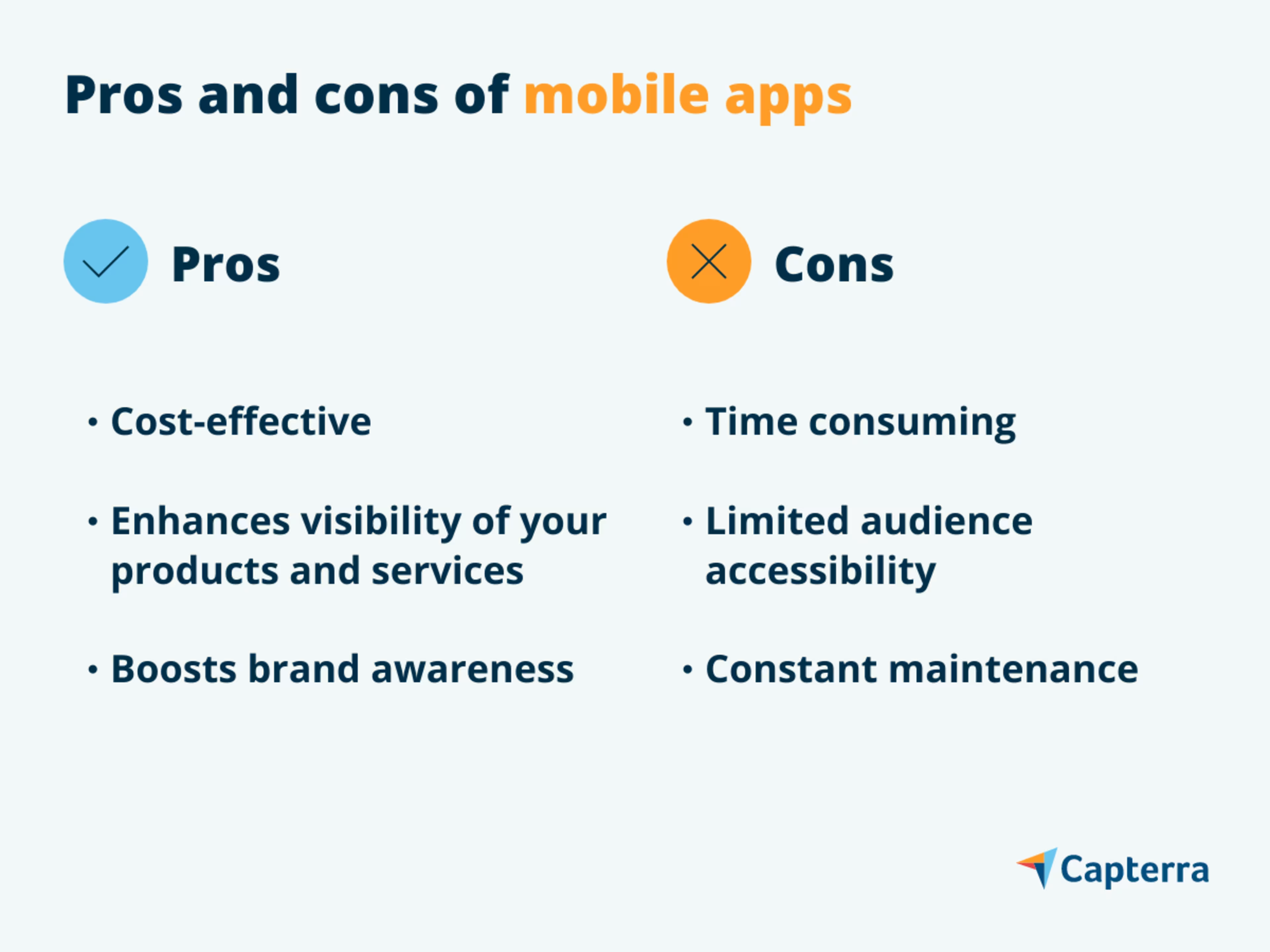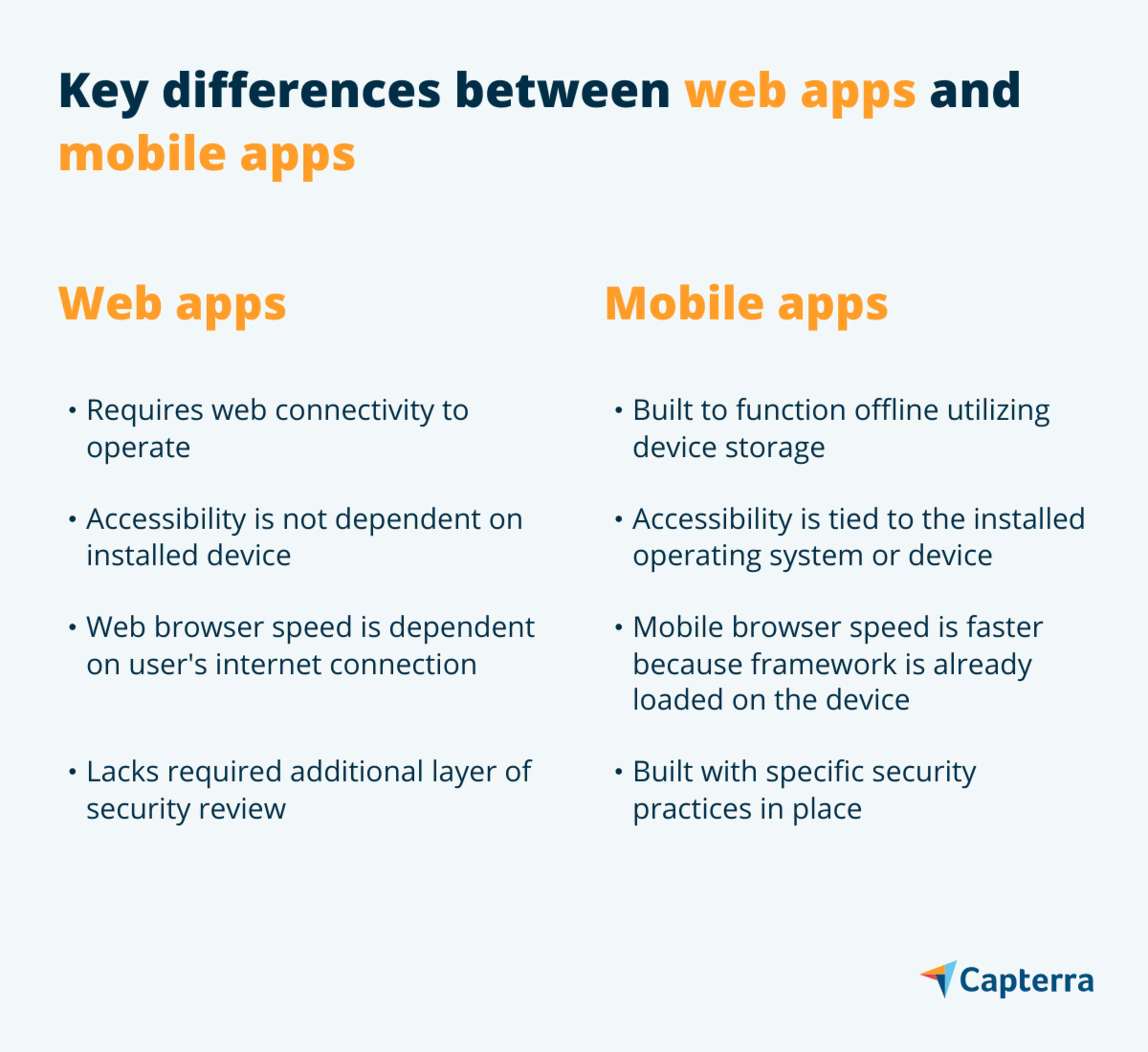Give customers the digital app experience that best supports their needs
Your digital real estate is just as important as any brick and mortar space you maintain. Aside from a website and social media presence, many businesses fold in a web or mobile app to support the customer journey.
In addition to the benefits of improving the visibility of the business, a mobile or web app also provides tools for improving customer engagement, introducing automation into the marketing process and the ability to gather data. This information provides the business with key insights and a competitive advantage in their business niche.
To help you decide which tool you should focus your investment on, we’ve broken down each type of software application, the benefits and drawbacks of each, and what to consider when deciding which route to go.
What is a web app?
Unlike static websites, web applications are software programs hosted from a web server that users can access via a web browser. These web-based programs offer a number of services to users, do not require downloads or installation, and often make up large parts of websites.
Types of web applications
Web applications come in a variety of formats and functions. The first delineation is in how interactive the web application is built to be for the user.
Static web applications are built to deliver portfolios or informational brochures and only change when manually updated.
Dynamic web applications are interactive and use a server-side database and mix of user- and server-side scripts to provide personalized experiences and custom content to users.
Beyond interactivity, web applications can further be broken down according to how they are presented to users.
Single-page applications (SPAs) update the content of the main page as users interact with it. This format is useful when speed of the user experience is paramount, such as for social media platforms and cloud-based software. Developers use JavaScript-based frameworks to ensure dynamic content and user interfaces are loaded as fast as possible.
Multi-page applications (MPAs) reload and replace the entire page as content changes through user interaction. Most often leveraged for eCommerce and content delivery platforms, MPAs handle complexity and databases more efficiently and are much more SEO friendly. However, this comes at the price of being slower and more resource-intensive.
Progressive Web Applications (PWAs)
These specialized hybrid applications are a mix of traditional webpages combined with built-in mobile applications. Users can download PWAs to a device’s home screen without having to load through an app store, and these applications can provide users with offline functionality and push notifications, as well as data synchronization once the app is connected to the web.
Rich internet applications (RIAs) are similar in that they provide users with an experience as if they were using a desktop application. They rely more on installed plug-ins and client-side frameworks to provide interactivity, but still operate within the web browser.
Other forms of web applications
There are several other types of web applications that users can come across in their daily professional and personal lives.
JavaScript web applications allow applications that can run both through the web browser and native to the device. These web applications are extremely fast, use resources efficiently, and can update parts of a page as needed rather than requiring a full update every time a user interacts with it.
Portal web applications provide a dashboard experience and a gateway towards an aggregate of other applications, and are often built for businesses as either a customer-facing service platform or a method for employees to gain access to the organization’s digital tools such as email, discussion forums, and news feeds.
Animated web applications are increasingly popular due to the gamification of marketing and the need for engaging visual content across marketing campaigns, but require significant resources and planning.

Benefits of web apps
With each type of web application bringing unique functionality and features to bear in order to enhance the user experience, web apps tend to provide three major benefits for businesses.
Scalability
Off-the-shelf software solutions and even custom-built platforms are often purchased or built to meet the current needs of the business. Web-based software solutions are built with scalability in mind, and have the benefit of being cloud-based. Cloud hosting and storage allows web apps to access additional resources or reduce the amount of resources they utilize to meet the needs of the user-base, adapting to growth or seasonal shifts in business.
Budget-friendly
When a company purchases a software solution off-the-shelf, they are paying for the platform as-is. Purchasing software this way carries the risk of either having to purchase additional add-ons to achieve the desired functionality or paying for a slew of unnecessary features in order to get access to the ones you’re looking for. Web apps are much more affordable, more cost-effective methods of deployment that are also more cost-efficient to maintain over time.
Accessibility
Because users can access web applications through a browser, they are resistant to the proprietary limitations of software applications built for specific operating systems or devices. Web applications provide users the ability to access your digital services from any device with internet access.
Cons of web apps
There are several drawbacks to building your services into web apps.
Limitations of online-only
Web applications are largely dependent upon online access in order to function. This is why progressive web applications, which are expected to grow 30% year-over-year through 2027, have become a popular alternative to traditional web applications.[1] The offline functionality and ability to synchronize with the hosted database once connectivity is established marries the benefits of traditional software platforms to the flexibility of web applications.
Inconsistent performance
While web applications aren’t impacted by the performance of the devices upon which they are being accessed, the user experience can suffer from slow load times due to poor design. Poor performance of the server can also impact the performance of the web application.
Security concerns
Web applications are susceptible to the same threats that websites and any digital assets are subject to. Cyber threats include unauthorized access, data breaches, and ransomware. Mitigating the risks that threaten web applications requires a broad range of standard security measures to be taken, including building secure coding practices and data encryption into the web application, implementing the proper API security measures, and scheduled security audits to ensure alignment with current best practices.
What is a mobile app?
Mobile applications are software designed to run primarily on laptops, smartphones, tablets, or any other mobile electronic device. Mobile apps are purpose-built to solve specific business problems, accomplish specific tasks, or provide an entertaining experience.
Types of mobile apps
Approaching the types of mobile applications from a technical perspective, there are three broad categories of applications being deployed by developers to mobile devices in the modern mobile landscape.
Native mobile applications
Native mobile apps are developed to run on a specific operating system. Developers use platform-specific software development kits (SDKs) and programming languages to utilize the full scope of features and functionality each operating system allows. As they are optimized for the platforms they are built for, native apps can take advantage of device-specific features and tend to offer superior experiences.
Web-based mobile applications
Mobile web applications are built using the same programming languages used for creating websites. They can be accessed by users through a web browser following a dedicated URL link. These applications are not downloaded to the device, so can be built as cross-platform compatible. Web-based mobile applications are also easy to maintain, as updates can be made on the server side without time consuming updates.
Hybrid Mobile Applications
Hybrid mobile applications are built using web technologies to allow for cross platform compatibility, but then are encapsulated within a framework that allows them to be installed and run on a device like a native application. Because the encapsulation is what allows cross-device compatibility, they don’t need multiple development cycles to ensure compatibility across operating systems or devices. While they may behave like a native application, they don’t necessarily offer the same speed and performance as one.

Benefits of mobile apps
Mobile applications introduce a wide range of benefits to your business that revolve around enhancing the customer experience:
Increases the personalized in-app experience of customers.
Improves customer loyalty through integrated rewards programs.
Serves as an additional channel for customer service engagement.
Provides value to the customer experience through enhanced customer engagement and direct communication.
Offers a secure experience due to stringent security requirements through mobile app stores.
Mobile apps are also important tools to help achieve a number of marketing initiatives:
Enhances the visibility of your products and services
Boosts brand awareness
Increases customer engagement boost revenues
Provides access to a wealth of customer data and insights.
Creates a cost-effective marketing channel.[2]
Cons of mobile apps
While an almost indispensable component in any modern business’s marketing arsenal, building a mobile app does have its drawbacks:
Mobile application development is time consuming and costly. Costs associated with mobile app development are higher than those for a web app often because multiple versions of the app have to be created for different operating systems and devices.
The audience reach of a mobile app is limited by the operating platforms and the types of mobile devices.
Mobile applications require updates and maintenance to keep up with the cycle of mobile device operating systems. These updates require costly and time consuming testing to ensure changes haven’t compromised functionality and security of the mobile app.
Key differences between web apps and mobile apps
While both types of digital applications provide users with an online experience, they go about doing so in significantly different ways, and the experiences can vary greatly.

Online accessibility
Mobile applications are often built to function while offline, utilizing device storage to provide a more seamless experience. Web applications, on the other hand, are often browser-based and, with the exception of PWAs, require connectivity to operate.
Device and operating system dependency
Many of the drawbacks and challenges in mobile app development revolve around mobile apps being tied to the operating system or device upon which they’re installed. Web applications are built specifically to be insulated against this device- and OS-dependency. Gartner research shows that this is why 90% of enterprises through 2025 will be using a combination of web, native, and hybrid mobile architectures to build more adaptable and flexible applications.[3]
Speed of the user experience
Mobile applications have an advantage in the speed in which they can deliver content because much of their framework is already loaded and installed on the device, making the browsing experience faster. Conversely, web applications are accessed through a web browser and dependent upon the speed of the user’s internet connection.
Standards of security
Because mobile applications are often downloaded from an app store, they have already undergone a fairly stringent review process to ensure that they’ve been built with specific security measures in place. Web applications don’t always have this additional layer of oversight because they can be directly downloaded from the web onto your device.
Web app vs. mobile app: Choose the best fit for your needs
Deciding which type of digital application you should create for your business largely depends on what you are looking to accomplish with the app and what sort of business you run.
The application development process can be lengthy and quite expensive, with the research and design phases being the most costly.[4] You need to conduct extensive market research and survey your targset audience to find out what they need from an application and how you might best meet those needs. Some questions you should ask:
Does the user experience require access to mobile device hardware?
This includes GPS location services, microphone, camera, and speaker. If so, then this might require a native mobile app approach.
Does the user experience need to be highly personalized?
While web apps can provide a one-size-fits all experience to reach a wide audience, native and hybrid applications are better at personalization and provide users with the experience they are looking for.
Will your ideal customer download another mobile application to their devices?
Gartner research revealed that during 2021 to 2022, website traffic decreased by 3% and monthly active app users only grew 1.5% during the same period. The research also discovered that only 3% of consumers surveyed feel they need more apps of any kind.[5]
If your market research shows that your ideal customer is more open to a web application, then there is no need to fold in the time and costs to also roll out a mobile application.
What is your budget for building out the right application for your needs?
Both mobile application development and web application development require significant investments, with the cost for a minimum viable product with limited functionality coming in between $140,000 and $210,000 on average.[6] Web applications are less expensive to develop, as mobile applications tend to require multiple builds in order to be launched across multiple platforms.
What business process do you intend to support with the application?
Are you looking to launch a web application to support your new eCommerce platform, or are you looking to gamify the customer experience through a loyalty program? These are very different experiences, each requiring a specific style of engagement and UX/UI for users. Understanding ahead of time which business process or level of interaction you’re trying to achieve for your customers will determine if you’re investing in a mobile application or building out a web application.
Web and mobile application software and services
Understanding the different approaches to application development is helpful, but the real issue that needs to be addressed is whether you are a small business owner or startup with the resources and expertise to build out a mobile application or web app in-house.
Unless you’re an agency or developer studio building and launching applications for clients already, chances are you don’t have all of the internal resources to launch a mobile app or web app on your own, and you could use the support of an agency.
Check out Capterra for a list of services directories to find a firm that can bring your plans for a mobile app or web app out of the planning process and into reality:
Discover more resources to help with your software research
If you’re not ready to outsource your development needs with one of our vendors linked above, and you need more information to decide which route might be best for you, you can check out these additional resources

